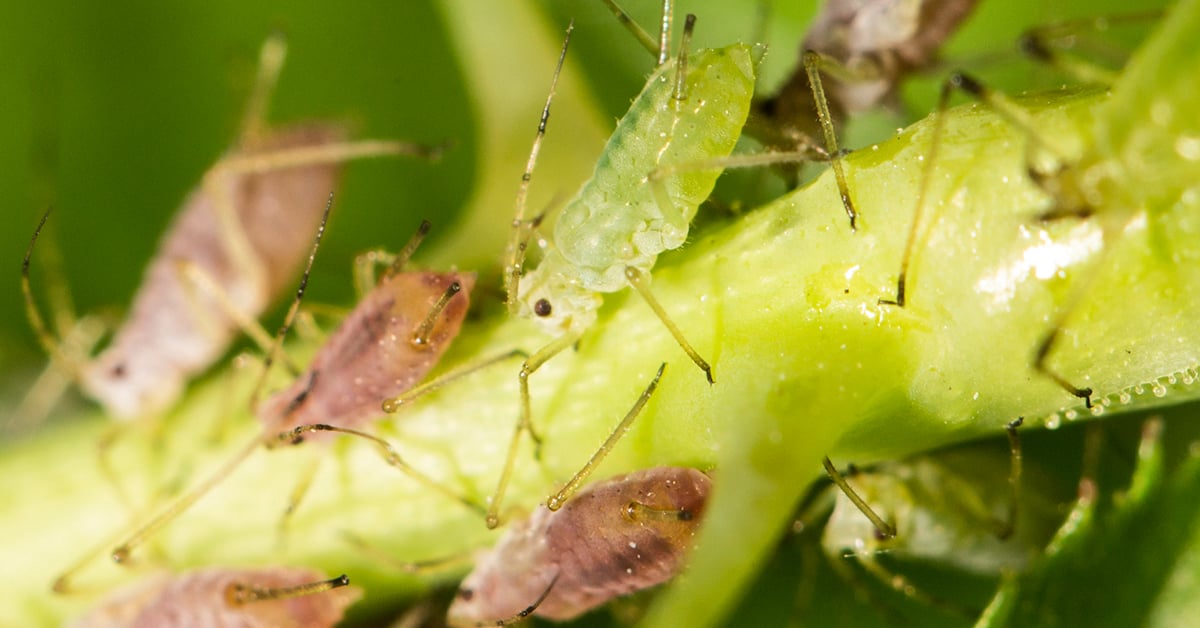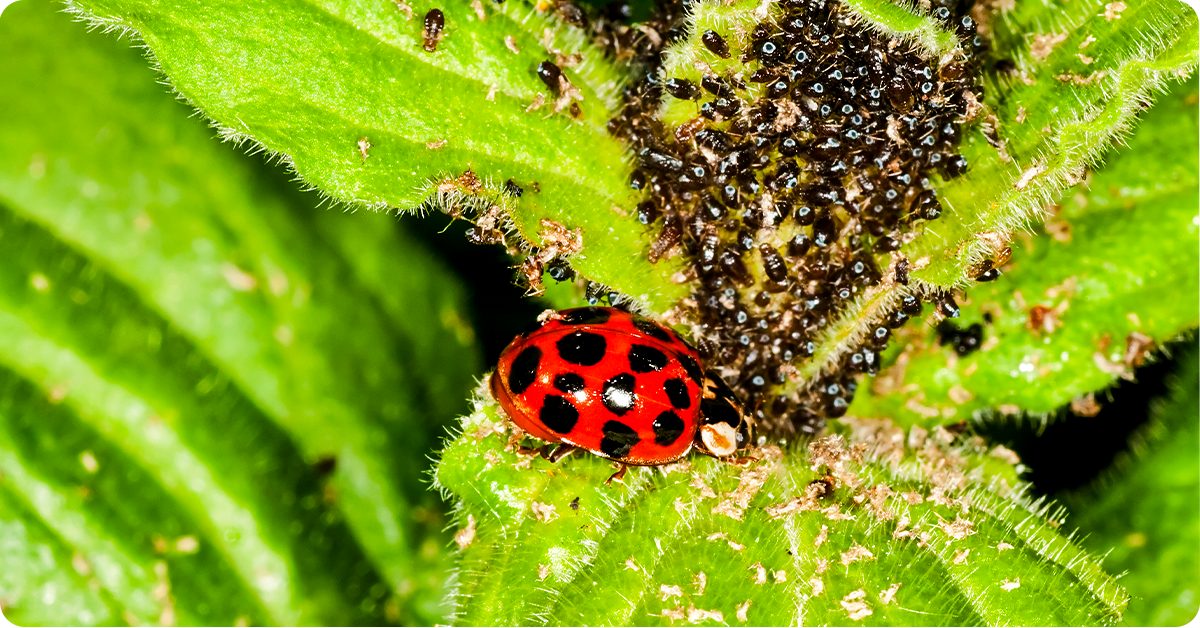
At first glance, your garden looks tranquil and pristine. Don’t let the unbothered beauty fool you, your plants are under attack. A closer inspection can reveal masses of tiny creatures intent on feeding off your tasty plants.
Aphids are small, nutrient-sucking insects that invade and feed off the liquid phloem inside plants. They’re a common pest around the world, and chances are you’ll encounter them at least a time or two. In most cases, aphids cause little to no visible harm, but heavy quantities can lead to significant plant damage.
Your prized house plants, garden vegetables, and even fruit trees are all susceptible to aphids. While it takes quite a few to conduct a full takeover, it’s best to control and prevent them before any big damage can be done.
What Are Aphids?
Aphids are small, pear-shaped insects that feed on the liquid in plants. They have soft bodies and can be green, yellow, orange, gray, black, or white depending on the variety. In order to protect your plants and control aphids, you will need to identify the pests and recognize signs of an infestation.

Signs of Aphid Damage
Signs of aphid-damaged plants will vary based on the size of the infestation as well as the type or variety of aphids present. Large infestations can cause rumpled, wrinkled, distorted, stunted, or curled new growth of leaves. Smaller infestations may not cause visible damage to the plant but will reduce overall productivity.
Here are a few signs that your plants may have aphid damage:
Visible Infestation – What do Aphids Look Like?
Locating and identifying aphids is the best way of knowing if the insects are the culprits behind your damaged plants. Aphids prefer tender new growth, so check the undersides of new leaves and buds for clusters of the small, soft-bodied insects. Also, check for aphid eggs that might be attached to the leaves or stems in clusters. Aphid eggs are oval-shaped and range in color from yellow, orange, and black.
Sticky Leaves
Aphids produce honeydew, a sticky excretion that contains proteins, amino acids, and sugars. This honeydew can be seen and felt on leaves and can even be found on vehicles and other objects under trees or plants where aphids are present.
Leaves with Black Spots
“Sooty mold” or black spots on the leaves and branches of plants is a type of fungus that grows on honeydew and is a good indicator of aphids. While the dark splotches are not necessarily harmful, they can reduce productivity and overall health by limiting photosynthesis.
Strong Ant Presence
Ants are often found on or around plants where aphids are present. The ants eat the nutrient-rich honeydew from aphids and are even known to protect the smaller insects from predators. If you see a large number of ants on or around your plants, you may have aphids.
Organic Aphid Control Methods (Contact Insecticides)
Horticulture Oils
Horticulture oils are an early season control option for trees and shrubs that suffocate overwintering aphid eggs while the plants are dormant. Coat the branches of deciduous trees and shrubs early in the spring while temperatures are still cool. Avoid using oils when temperatures are high as it can burn plant foliage.
Neem Oil
Neem oil is a naturally occurring pesticide produced from the seeds of neem trees. Neem oil interacts with the hormone system of aphids and reduces insect feeding. Some neem oil products such as Triple Action Neem oil will mix neem oil with other control options for a longer-lasting, residual control of aphids. Like horticulture oils, applying neem oil during peak temperatures can cause burning on plants.
Insecticidal Soaps and Fatty Acid Salts
Insecticidal soaps and fatty acid salts disturb the cell membranes of aphids and are listed for use in vegetable gardens and on landscape plants. When using these methods you should cover new growth of plants completely, including the undersides of leaves as this is where most Aphids are found. Also check to be certain that daytime temperatures will be below 80 degrees to avoid foliage burn. These products do not have residual effects, meaning they will not harm beneficial insects once they have dried.
Chemical Aphid Control Methods (Residual Insecticides)
Imidacloprid
Imidacloprid Tree and Shrub Drenches are effective when applied to ornamental landscape plants about 6 to 8 weeks before the plants begin leafing out. The imidacloprid settles in new buds and leaves and kills the aphids when they feed. Do not use Imidacloprid drenches in fruiting plants.
Pyrethroids
Pyrethroids are man-made Pyrethrins that provide extended control of Aphids. The Pyrethroids excite an insect’s nervous system leading to paralysis. Examples of effective Pyrethroids include Garden & Farm Insect Control (Permethrin), Indoor & Outdoor (Permethrin), Eight (Lambda-cyhalothrin) and Sevin (Zeta-cypermethrin).
Malathion
Powders and sprays containing Malathion are best for controlling Aphids hidden in rolled leaves. These products have a strong residual effect that makes it good for controlling aphids that might not have had direct contact with the insecticide. Malathion affects an insect’s nervous system, causing a disturbance in brain signals and processes.
Important Note: Avoid using products with the same active ingredient by rotating any chemical or organic treatment methods that you may use. This will help prevent insects from developing a resistance to these products.
Natural Control Methods
Predatory Insects
Ladybugs, Lacewings and Parasitic Wasps are all aphid predators that can be introduced to manage aphid populations. This control method is safe for all plant types but is not 100% effective and will take longer than other control methods. It takes time for predatory insects to find the aphids and even introducing them to aphid-infested plants does not guarantee they will stay. If you decide to introduce predatory insects to your plants, be sure to get rid of the ants first as they will protect the aphids by blocking or killing the predatory insects.
Water
If there are few aphids, a sharp stream of water from a spray bottle may be all you need to knock them off plants and new growth. Once off the plant, they cannot climb back up and will usually starve to death. By repeating this method daily, you can effectively control aphids.

Protecting Plants From Aphids
The best way to protect your plants from possible aphid damage is by preventing a large infestation.
1. Consider Using Dormant Oil
Using a dormant oil in late winter to early spring (January to late March in most areas) will suffocate the overwintering insects and eggs.
2. Be Picky About Your Plants
Check your plants before you purchase them. Be sure to look at newer growth and especially under leaves. Do not buy plants that are already infected with aphids that could infest your yard or garden.
3. Remove Debris
Garden debris as well as tree and shrub limbs provide additional options for aphids to call home that you likely won’t check like your living plants. Keep your yard or garden free of debris after spring or fall clean-ups to reduce possible aphid hosts.
4. Maintain Healthy Plants
Healthy plants are better able to withstand aphid infestations. Help your plants by using fertilizers and soil conditioners as recommended, sticking to a regular watering schedule and reducing weeds that might compete with the plants.
5. Weekly Checks
Check your vegetable garden and other new plantings weekly for signs of aphids on the plant and especially under leaves. If you can identify them early, a robust spray of cold water is all that is needed to control a low infestation.
Growing the Plants You Love
From the yard to the garden, you spend countless hours caring for the plants you grow and love. Protecting those plants from aphids is just another way to keep your garden and yard healthy and productive.
Stop by your local IFA Country Store for tools and aphid-control essentials. If you have any questions about aphid control methods, reach out to a knowledgeable member of our IFA team.
Information for this article was provided by Tina Potter, Utah Certified Nurseryman, Washington State Certified Nursery Professional (Lifetime), & Lawn & Garden Dept., Ogden IFA Country Store; and Marvin Potter, Garden Center and Live Plants Category Manager, IFA Country Store.











